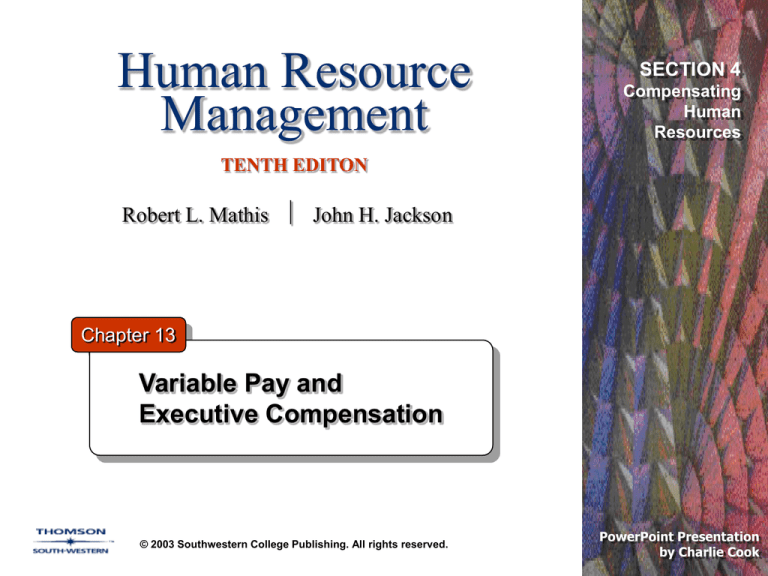
Human Resource
Management
SECTION 4
Compensating
Human
Resources
TENTH EDITON
Robert L. Mathis John H. Jackson
Chapter 13
Variable Pay and
Executive Compensation
© 2003 Southwestern College Publishing. All rights reserved.
PowerPoint Presentation
by Charlie Cook
Learning Objectives
After you have read this chapter, you should be
able to:
– Define variable pay and give examples of three
types of variable pay.
– Identify four guidelines for successful incentive
programs.
– Discuss three types of individual incentives.
– Explain three different way that sales employees
typically are compensated.
– Identify key factors that must be addressed when
using team variable pay plans.
© 2002 Southwestern College Publishing. All rights reserved.
13–2
Learning Objectives (cont’d)
– Discuss why gainsharing, profitsharing, and
employee stock options have grown as
organizational incentive plans.
– Identify the components of executive compensation
and discuss criticisms of executive compensation
levels.
© 2002 Southwestern College Publishing. All rights reserved.
13–3
Variable Pay: Incentives for Performance
Variable Pay Systems
Service Pay Systems
Some jobs contribute more to the
organization than others.
Time spent is the primary
measure of employee contribution
Some people perform better than
others.
Length of service is the primary
differentiating factor among
people.
Employees who perform better
should receive more
compensation.
Contributions are recognized
through different amounts of base
pay.
A portion of some employees’
total compensation should be
contingent on performance.
Apportioning rewards based on
individual performance is
considered to be divisive.
© 2002 Southwestern College Publishing. All rights reserved.
13–4
Types of Variable Pay Plans
Figure 13–1
© 2002 Southwestern College Publishing. All rights reserved.
13–5
Factors Affecting Variable Pay Plans
Does the plan fit
the organization?
Variable Pay
Plan Success
Are the right behaviors
encouraged by the plan?
Is the plan being
administered properly?
© 2002 Southwestern College Publishing. All rights reserved.
13–6
Factors for
Successful
Variable Pay
Plans
Figure 13–2
© 2002 Southwestern College Publishing. All rights reserved.
13–7
Individual Incentives
Identification of
Individual
Performance
Independent
Work
Individual
Incentive Pay
Plans
Individualism
Stressed in
Organizational
Culture
© 2002 Southwestern College Publishing. All rights reserved.
Individual
Competitiveness
Desired
13–8
Piece-Rate Systems
Straight Piece-Rate Systems
– Wages are determined by multiplying the number
of pieces produced by the piece rate for one unit.
Differential Piece-Rate Systems
– Employees are paid one piece-rate for units
produced up to a standard output and a higher
piece-rate wage for units produced over the
standard.
© 2002 Southwestern College Publishing. All rights reserved.
13–9
Bonuses and Special Incentive Programs
Bonus
– A one-time payment that does not become part of
the employee’s base pay.
Awards
– Cash or merchandise used as an incentive reward.
Recognition Awards
– Recognition of individuals for their performance or
service to customers in areas targeted by the firm.
Service Awards
– Rewards to employees for lengthy service with an
organization.
© 2002 Southwestern College Publishing. All rights reserved.
13–10
Sources of Bonuses
Source: Kathryn F. Clark, “Incentives Increase But Competitive Base Salary Key in
Talent Race,” Human Resource Executive, June 2, 2000, 30. Used with permission.
© 2002 Southwestern College Publishing. All rights reserved.
Figure 13–3
13–11
Different Bases for Sales Incentives, In Order of Use
Figure 13–4
© 2002 Southwestern College Publishing. All rights reserved.
13–12
Sales Compensation Plans
Salary Only
– All compensation is paid as a base wage with no
incentives.
Commission
– Straight Commission
• Compensation is computed as a percentage of sales in
units or dollars.
• Draw system make advance payments against future
commissions to salesperson.
– Salary Plus Commission or Bonus
• Compensation is part salary for income stability and
part commission for incentive.
© 2002 Southwestern College Publishing. All rights reserved.
13–13
Why Organizations Establish Team Pay Plans
Figure 13–5
© 2002 Southwestern College Publishing. All rights reserved.
13–14
Group/Team-Based Variable Pay
Determining
Individual
Rewards
Timing of
Team Incentives
Distributing
Team
Incentives
Deciding the
Allocation of
Rewards
© 2002 Southwestern College Publishing. All rights reserved.
13–15
Conditions for Successful Team Incentives
Figure 13–6
© 2002 Southwestern College Publishing. All rights reserved.
13–16
Gainsharing
Gainsharing
– The sharing with employees of greater-thanexpected gains in productivity.
– Alternatives for rewards distribution:
•
•
•
•
A flat amount for all employees
Same percentage of base salary for all employees
Percentage of the gains by category of employees
A percentage based on individual performance against
measures
© 2002 Southwestern College Publishing. All rights reserved.
13–17
Profit Sharing
Profit Sharing
– A system to distribute a portion of the profits of the
organization to employees.
– Primary objectives:
• Improve productivity
• Recruit or retain employees
• Improve product/service quality
• Improve employee morale
– Drawbacks
• Disclosure of financial information
• Variability of profits from year to year
• Profit results not strongly tied to employee efforts
© 2002 Southwestern College Publishing. All rights reserved.
13–18
Profit-Sharing Plan Framework Choices
Figure 13–7
© 2002 Southwestern College Publishing. All rights reserved.
13–19
Employee Stock Ownership Plans (ESOPs)
Employee Stock Ownership Plans
– A plan whereby employees gain stock ownership in
the organization for which they work.
ESOP Advantages
– Favorable tax treatment for ESOP earnings
– Employees motivated by ownership in the firm
ESOP Disadvantages
– Retirement benefit is tied to the firm’s performance
– Management tool to fend off hostile takeover
attempts.
© 2002 Southwestern College Publishing. All rights reserved.
13–20
U.S. CEO Remuneration
Source: The Economist, May 8, 2000, 16.
© 2002 Southwestern College Publishing. All rights reserved.
Figure 13–8
13–21
Executive Compensation Components
Figure 13–9
© 2002 Southwestern College Publishing. All rights reserved.
13–22
Common Executive Perks
Figure 13–10
© 2002 Southwestern College Publishing. All rights reserved.
13–23
Arguments
in the
Executive
Pay Debate
Figure 13–11
© 2002 Southwestern College Publishing. All rights reserved.
13–24




